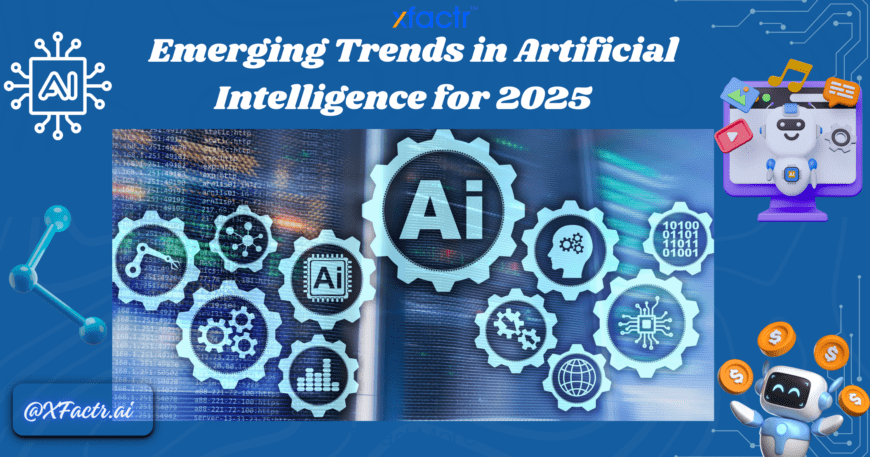Artificial Intelligence (AI) continues to evolve, driving innovation and transforming industries worldwide. As we enter 2025, AI is taking on new dimensions, integrating more deeply into our daily lives and reshaping the future of technology. Here’s a look at the most exciting AI trends that are shaping the landscape this year:
1. Generative AI: Beyond Creativity
Generative AI tools like ChatGPT, DALL-E, and others are no longer just novelties—they are redefining industries.
- Applications: Content creation, design, drug discovery, and education are seeing unprecedented growth in AI-driven solutions.
- Advancements: Models are becoming more nuanced, context-aware, and capable of generating hyper-personalized content.
🔮 Future Outlook: Expect tighter integration of generative AI in customer service, e-commerce, and healthcare.
2. AI-Powered Automation in the Workforce
AI-driven automation is streamlining repetitive tasks, allowing professionals to focus on strategic decision-making.
- Industries Impacted: Manufacturing, logistics, and customer support are increasingly embracing robotic process automation (RPA).
- Human Collaboration: AI is enhancing productivity by working alongside humans, not replacing them.
🤝 Future Outlook: Collaborative AI tools will bridge the gap between human creativity and machine efficiency.
3. Responsible AI and Ethics
As AI becomes more powerful, the demand for ethical, transparent, and accountable AI systems is growing.
- Focus Areas: Fairness in AI algorithms, mitigation of bias, and greater transparency in decision-making processes.
- Regulations: Governments and organizations are establishing frameworks to ensure responsible AI deployment.
🌍 Future Outlook: Expect stricter regulations and the rise of AI ethics officers in organizations.
4. AI in Healthcare
AI is transforming healthcare by improving diagnostics, treatment personalization, and operational efficiencies.
- Key Innovations: AI-driven wearable devices, virtual health assistants, and drug discovery.
- Impact: Faster disease detection, reduced healthcare costs, and enhanced patient outcomes.
❤️ Future Outlook: The integration of AI in telemedicine and preventive care will continue to expand.
5. Edge AI: Intelligence at the Source
Edge AI is bringing computation closer to the data source, reducing latency and enhancing real-time processing.
- Applications: Smart devices, autonomous vehicles, and IoT applications.
- Advantages: Improved privacy, reduced bandwidth usage, and faster decision-making.
📱 Future Outlook: Growth in industries like automotive, smart cities, and consumer electronics.
6. AI-Driven Cybersecurity
With increasing cyber threats, AI is playing a pivotal role in identifying and mitigating risks.
- Capabilities: Threat detection, real-time monitoring, and predictive analysis.
- Challenges: The rise of AI-powered cyberattacks, necessitating equally advanced defenses.
🔐 Future Outlook: AI-based systems will become the backbone of organizational cybersecurity frameworks.
7. Multi-Modal AI
Multi-modal AI systems can process and analyze multiple types of data—text, images, and audio—simultaneously.
- Examples: Systems capable of generating image captions or answering complex queries by combining different data formats.
- Implications: Improved accessibility, smarter virtual assistants, and enhanced user experiences.
🎥 Future Outlook: Multi-modal AI will dominate in education, entertainment, and virtual reality applications.
8. AI in Climate Action
AI is emerging as a powerful ally in addressing climate change.
- Applications: Energy optimization, climate modeling, and waste reduction.
- Impact: Smarter resource management and improved sustainability efforts.
🌱 Future Outlook: AI will play a crucial role in achieving global sustainability goals.
9. AI-Powered Language Translation
Breaking language barriers, AI-driven translation tools are becoming more accurate and culturally aware.
- Tools in Action: Real-time translation apps, voice recognition systems, and multilingual customer support.
- Advantages: Enhanced global communication and accessibility.
🌐 Future Outlook: Increased adoption in international business and education.
10. AI Democratization
AI is becoming more accessible to individuals and small businesses, thanks to no-code and low-code platforms.
- Impact: Democratized innovation and a surge in AI-powered startups.
- Examples: AI-driven tools for content creation, analytics, and automation.
🚀 Future Outlook: AI will empower people from non-technical backgrounds to innovate.
Conclusion
The AI landscape in 2025 is marked by rapid advancements, ethical considerations, and transformative applications across industries. As these trends evolve, they promise to make AI more accessible, intelligent, and impactful, ushering in a new era of innovation and opportunity.
What trends excite you the most about AI in 2025?


